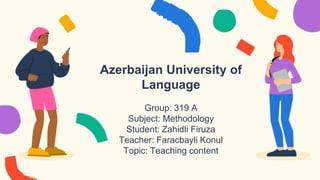
firuse meth.pptx
- 1. Azerbaijan University of Language Group: 319 A Subject: Methodology Student: Zahidli Firuza Teacher: Faracbayli Konul Topic: Teaching content
- 2. WHAT IS THE MEANING OF CONTENT?
- 3. Content means topic that texts are about, or that tasks relate to, as distinct from the target language itself
- 4. THERE ARE DIFFERENT KINDS OF CONTENT
- 5. 1.Zero or trivial content. Bland, fairly neutral characters and events; superficially interesting topics with no cultural or other information or connection with real-world issues. 2.The students themselves. Exploration of students' own experiences, knowledge, opinions and feelings: for example, activities that ask students to write about someone they know, or compare tastes in food and drink. 3.The local environment. Treatment of institutions, people, places, events, etc. from the students' own country or background. For example, Greek students might discuss places they would recommend that tourists should visit in Greecee
- 6. 4.Moral, educational, political or social problems; cultural issues. Presentation of issues showing different points of view, and encouraging students to express opinions: for example, an article describing a social conflict, or a dilemma to which students suggest a solution. 5.Another subject of study. Topics based on other subjects on the school or university curriculum, such as science or history. In some cases, an entire school subject may be taught in English. 6.(Native) English-speaking countries. Discussion of institutions, etc. from countries where English is spoken as a native language. Materials might cover British or American history, culture and customs, famous people, etc.
- 7. 7.World or general knowledge. Information or cultural artefacts from anywhere in the world: customs or festivals associated with another community, for example, or the history of a particular country, or world current events, or jokes, proverbs, etc, translated from other languages. 8.Literature. To some extent a part of points 6 or 7 above, but important enough to be listed as a separate section: stories, novels, plays and poetry written in English or possibly translated into it. 9. Linguistics. Aspects of English or language in general as topics of study in themselves. Some examples might be the history and development of the English language, the etymology or morphology of words, other interesting linguistic phenomena.
- 8. Source of cultural content of teaching materials. Home culture The culture of the (native) English- speaking peoples The cultures of other speech communities. 01 03 02 04 Global cultural norms
- 9. 1. Home culture. The topics relate to the native country. They encourage students to discuss local issues and relate to their own experiences, beliefs, customs, etc. The way the materials deal with the content may also reflect the home culture: not only the actual texts, but also the design. 2. The culture of the (native) English- speaking peoples. For most of the twentieth century, most English language teaching materials, especially at more advanced levels, included a large component of British and American culture. They included not only literature, but also texts about British or American customs or institutions.
- 10. 3. The cultures of other speech communities. This component is noticeably more important in modern materials. A typical coursebok today will include units on different countries and peoples, and customs and literature from various sources. One reason is simply that because of faster and more widely used communications and increasing travel, people are far more aware of events and cultures elsewhere. Another, related, reason is that today’s students are likely to need English to communicate with other English speakers with different L1 and a different culture. 4. Global cultural norms. Culture with a capital C has for some time been international. Museums displaying Asian or African art, concerts of music by European composers, and libraries with translated books from authors of all nationalities can be found in most countries. But it is a relatively recent phenomenon that certain norms and conventions have begun to be accepted and used worldwide. These include things like dress, politeness norms and forms of communication.
- 11. Literature as a component of the English course
- 12. Advantages • It can be enjoyable and motivating. • It can widen students' horizons by providing knowledge about the culture • which is the background to the text. • It encourages empathetic, critical and creative thinking. • It raises awareness of different human situations and conflicts. • Literature study has value in itself, like any other school subject. • It provides examples of different styles of writing, and representations of • various authentic uses of the language. • It is a good basis for vocabulary expansion • It develops reading skills. • It can provide an excellent starting point for discussion or writing.
- 13. Disadvantages and problems • A lot of literature is written in language that may be difficult for students to read (we can use simplified versions, but these are inevitably inferior to the original) • Many literary texts are long and time-consuming to teach. • The culture on which the literature is based is alien to students and may be • difficult for them to relate to. • By using texts as a basis for language teaching, we may spoil students' enjoyment and appreciation of them as literature. • Many students may feel that literature is irrelevant to their needs (e.g. student learning English for business or other specific purposes).